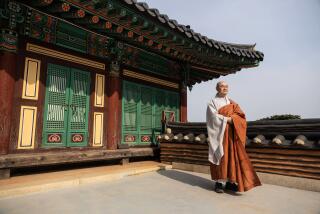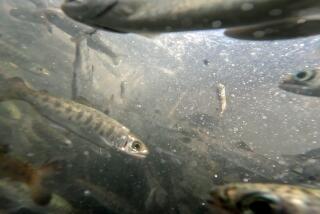Environment : Buddhist Rite Brings Bad Fortune to Fish : Foreign species, released into waters during the annual ritual, are eating the eggs of the native carp, scientists say.
SEOUL â For centuries, Korean Buddhists, in a symbol of respect for life in all forms, have conducted ceremonies releasing fish into ponds, lakes, reservoirs, rivers and the sea--a ritual that now finds them accused of disrupting the ecology.
Critics say that some 25 species of indigenous fish have disappeared from parts of South Korea because among an estimated 2 million fish released by Buddhists here each year are foreign species originally brought into the country for fish-farm experiments. The âforeigners,â it seems, are eating the eggs of the ânatives.â
Further, some Buddhist experts contend that the fish-releasing rituals themselves have degenerated into an exercise aimed at personal aggrandizement rather than a celebration of the rejuvenation of life.
âMany Buddhists release a fish hoping that the act will help a son seeking admission to college, a daughter looking for a husband or a turn of fortunes for themselves,â complained Mok Jeong Bae, a professor at Dongguk University, a Buddhist college in Seoul.
Virtually every lake, pond and reservoir in South Korea has been taken over by bluegills, a hearty fish originally imported from the United States in the early 1970s, said Prof. Choi Ki Chul of Seoul National University, a fish expert. Unlike Korean species, the bluegill father hovers over the eggs laid by his spouse and protects them until they hatch. Meanwhile, male and female bluegills eat the eggs left unprotected by native fish varieties, Choi explained.
Silver carp that used to prevail in ponds and reservoirs have been shunted aside by the bluegills--âmuch to the disappointment of amateur fishermen, who found the silver carp delicious to eat,â the professor said.
Meanwhile, the big-mouth bass, another import from the United States, has driven into extinction some 25 species native to the upper Han River, according to a team of experts who surveyed the waterway at the request of the Environment Ministry. The species that have disappeared still exist in other rivers, while the big-mouth bass are found only in the Han, Choi said.
Nonetheless, the Seoul professor isnât ready to blame foreign species exclusively.
Sightings of the big-mouth bass in the Han began only in the mid-1980s, and pollution, which set in earlier, may have had more to do with the demise of the ânatives,â he said. Also, so many dams and reservoirs have been built that the riverâs water has been slowed to a âlake-styleâ flow.
âItâs hard for river fish to live in lake-like water,â Choi said.
Many Buddhists have no idea whether a particular type of fish is suited to the waters into which they release it, Mok said.
The ritual dates back to ancient China and became rooted in Korea in the Koryo Dynasty (918 to 1392), Mok explained. It stems from a sutra scripture telling of a rich businessman who bought fish from fishermen and then released them while still alive to demonstrate the Buddhist belief that all life is precious, whatever its form.
Ceremonies are now held every April, the Dongguk University professor said.
âIn recent years, it has grown more and more egotistic, losing its revered atmosphere,â Mok said. âRather than having a monk release a single fish on behalf of all believers, each participant wants to release a fish to seek a reward for himself.â
Fishermen, too, have latched onto the ceremonies to reap profits. They sell fish to worshipers, then recapture them in nets laid near the riverbank after the first group of Buddhists releases them. They haul the fish back to shore to resell their catch to the next group.
âSometimes the fish have been caught, released and caught so many times that some of them get exhausted and die. It winds up quite the opposite of replenishing life,â Mok said.
In addition, some fish brought to rivers from fish farms arenât accustomed to running waters and die after they are released into rivers, he added.
A better ritual, the professor said, is another Buddhist custom of cutting a hole in the ice on a river in the dead of winter, lighting a candle to attract fish and dropping small bags filled with rice in the water to offer nourishment when plankton are scarce.
âUnfortunately, because people usually cannot see the results of that offering, worshipers favor the ritual of releasing fish into streams,â he said.
At least 2 million people throughout the country release fish every year, Mok said, adding, âNo wonder they must use imported fish!â
Complicating matters is the fact that Koreaâs Buddhists are split into 28 sects, each of which follows the teaching of a different sutra, Mok said. The upshot is that the Buddhist community canât offer effective guidance on how to carry out the ritual, Mok said.
The national census shows that some 20 million South Koreans, or about 45% of the population, claim to be Buddhists--âalthough probably 5 million of them never go to a temple in their lives,â Mok said. âThere is no way to force believers to attend temples. Thatâs why it is very difficult to organize Buddhists.
âLogically, the solution (to the ecology problem) would be to stop this nonsensical (fish-releasing) practice. But any temple that desists would soon find itself bankrupt,â Mok said. âWorshipers pay about 30,000 won ($38.60) to participate. For 1,000 participants, that means 30 million won ($38,600).â
âUnlike Christian churches, with regular services, temples have to stage mammoth rituals to draw out believers. When monks hold instruction meetings to enlighten believers, few attend. Thatâs why I am very gloomy about the future of Korean Buddhism,â he said.
More to Read
Sign up for Essential California
The most important California stories and recommendations in your inbox every morning.
You may occasionally receive promotional content from the Los Angeles Times.










